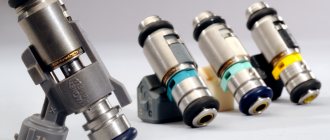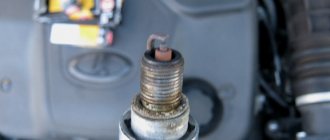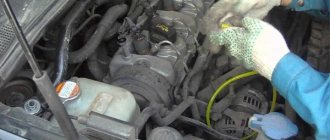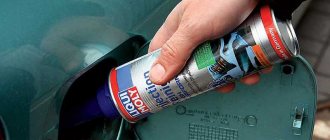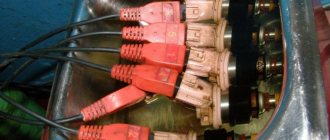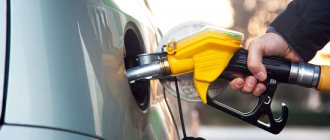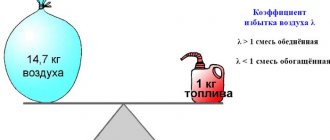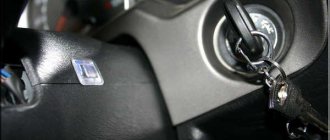06.12.2019
| (Votes: 1, Rating: 5) |
Issues discussed in the material:
- Why do you need to periodically clean fuel injectors?
- How to understand that the time has come
- What methods are there for cleaning fuel injectors?
Uninterrupted engine operation is possible only if the fuel system is clean. If it is clogged, the car owner will face higher fuel consumption and difficulty starting the engine. Timely maintenance is important for fuel injectors; most often, cleaning and flushing are enough to restore normal operation. In this article we will talk about what cleaning fuel injectors is.
Why do you need to clean fuel injectors?
The injectors operate as follows: an electrical impulse from the ECU arrives at the injector connector, activating the electromagnet winding (coil) and exciting the electromagnetic field. The field influences the electromagnet in such a way that it moves and lifts the spray needle above the seat, opening the nozzle. After the nozzle opens, fuel is injected into the intake manifold. When the electrical impulse stops, the pressure spring returns the injector needle to its original position, stopping fuel injection. The pulse lasts about 2-3 ms.
The burning air-fuel mixture leads to the formation of a tar deposit that settles in the engine combustion chambers and injector nozzles. Coke deposits contaminate the nozzles, narrowing their diameter and changing their shape. As a result, not only the amount of fuel entering the internal combustion engine is reduced, but the atomization process changes.
The air-fuel mixture ceases to be homogeneous; instead, streams of fuel enter the engine. The concentration of oxygen or gasoline may increase, which negatively affects the operation of the power unit, fuel consumption, etc. Due to less efficient evaporation of fuel in winter, the process of contamination of injectors occurs faster.
Having noticed that sharply pressing the accelerator leads to jerks and dips in the engine, instability of its operation at low speeds or at idle, as well as when power decreases and fuel consumption increases, you should check the condition of the injectors. The listed problems may indicate their coking, i.e., severe contamination with solid combustion products that prevent free fuel injection.
Cleaning fuel injectors is not always able to solve the problem. Since these symptoms may be caused by other reasons. However, flushing itself is a fairly simple and economical way to eliminate a possible source of trouble.
If the injector spray is incorrect, the formation of the air-fuel mixture is disrupted - fuel and air are mixed in the wrong proportions. The better the atomization, the smaller the size of the fuel droplets; accordingly, the contact area between fuel and air is larger, and the mixture formation is more efficient.
We recommend
“How to wash injectors: a review of methods and auto chemicals” Read more
For the spray, its uniformity is essential. A sign of a clogged fuel injector is the injection of a jet instead of spraying the mixture. The formation of coke results from the combustion of resins contained in the fuel. The worse the quality of the fuel, the higher their concentration in it. Cleaning fuel injectors can remove coking and restore normal functioning of the vehicle's fuel system.
Is it necessary to clean the injector in new or almost new cars with low mileage?
Of course, the life of the engine and all its components depends on many factors, for example, such as scheduled vehicle maintenance, which usually includes timely replacement of engine oil, replacement of filters, spark plugs, etc. work.
And also do not forget that the time of sedimentation in the injector, fuel injectors and combustion chamber depends on these same engine components.
For example, if you do not change the engine oil on time, do not change the oil filter, air filter and spark plugs for a long time, then this can only speed up the process of formation of carbon deposits in the engine.
As for new or almost new vehicles with low mileage, injector cleaning is most likely not necessary in this case, since due to low mileage carbon deposits will not yet appear.
So, if the mileage of your car does not exceed 40,000 - 50,000 km, and its age has not yet exceeded 3 years, then it is unlikely that it needs a procedure for cleaning the injector and other components of the injection system.
How to tell when it's time to clean your fuel injectors
Experts recommend cleaning fuel injectors every 30 thousand km.
The need to clean fuel injectors is indicated by:
- Difficulty starting the engine despite the starter being activated;
- vibrations during operation of the power unit;
- instability of idle speed;
- reduction in engine power;
- significant increase in fuel consumption;
- increased exhaust smoke;
- extraneous sounds when accelerating.
The listed symptoms do not appear all at once. Most often, problems with injectors occur after a mileage of about 100 thousand km. The use of low-quality fuel contributes to faster failure of injectors.
Fuel injector contamination can be divided into three stages:
- Small stage . Injector performance drops by 5–10% with a simultaneous increase in fuel consumption by 1–2 liters. There are no interruptions in the operation of the power unit.
- Middle stage . The reduction in productivity reaches 10–20% with an increase in fuel consumption by 2 liters. The engine shakes during operation. Exhaust gases acquire a characteristic pungent odor. There is a noticeable decrease in acceleration dynamics.
- Strong stage . Performance deterioration of up to 50% or more. A strong knocking sound from the engine is noticeable, caused by the failure of 1-2 cylinders, which do not receive fuel due to coking. A sharp press on the accelerator is accompanied by popping noises. Symptoms characteristic of the middle stage appear more clearly.
Carbon is the building block for deposits inside the engine.
When it comes to harmful carbon deposits in the engine, such deposits are considered the No. 1 enemy for all types of ICE (internal combustion engines) engines. Unfortunately, we must admit that the formation of carbon deposits inside the internal combustion engine is inevitable.
Carbon is a byproduct of using gasoline as an energy source to run the engine. So these carbon deposits inside the engine are sure to appear in any internal combustion engine, no matter how you use your car. It all depends on how quickly they appear inside the engine.
Basically, the entire inside of the engine can be compared to an oven. For example, if you grill one chicken in your oven, your clean oven will likely remain uncontaminated. But, if you cook chicken in this oven every day and so on for 5 years, and after that you also do not clean the oven from carbon deposits or other accumulated dirt, then all this will lead to the terrible condition of your oven.
The same thing happens in your car engine.
ICE engines have a certain thermal cycle, they heat up from ambient temperature to operating temperature, and then, after they are turned off and stopped, they cool back down. And this happens constantly throughout the operation of the machine.
This constant change in temperature leads to the formation of carbon deposits inside the engine itself and in the fuel injection system.
But this is not the only reason for such deposits. For example, a malfunction of the exhaust gas recirculation system (valve failure) can also lead to accelerated formation of carbon deposits inside the engine.
But one of the most important factors that influence carbon deposits in the engine is undoubtedly the quality of the fuel itself. For example, if you often use low-octane low-quality fuel to refuel your car or fill your regular car with very high-octane fuel, which is intended only for powerful sports car engines (contains many detergent chemicals - additives), then this will also lead to the rapid formation of serious deposits, such as inside the engine itself and in its injection system.
How to clean fuel injectors
Cleaning fuel injectors involves removing accumulated deposits from their channels.
You can clean the injectors by:
- ultrasonic cleaning (carried out at the service center);
- special fuel additives;
- washing fuel injectors using special liquids on a stand (performed at a service station);
- manual washing using special liquids.
The most effective way is to manually clean fuel injectors with special liquids. Washing injectors on a special stand copes well with contaminants, and you can use improvised means.
Ultrasonic cleaning of fuel injectors can only be performed using special equipment; in addition, it is more aggressive than using flushing liquids. This method is effective provided that the coking of the injectors is high and the liquid is not able to cope with it. Some experts say that when using ultrasound, the internal part of the elements is destroyed. Therefore, this method should be used only in cases where others are powerless.
We recommend
“Replacing Volkswagen injectors: when is it required and how to do it” Read more
The use of additives added to fuel to clean injectors without dismantling them is ineffective, and therefore is of a preventive nature. But even for prevention, it is worth using additives carefully, since the “chemistry” in the exhaust gases does not have the best effect on lambda probes.
To perform the operation of cleaning fuel injectors, you need to stock up on:
- flushing liquid;
- silicone tube, the internal diameter of which is approximately 5 mm;
- two wires of the same size;
- button;
- source of electricity (battery);
- electrical tape;
- tools.
The effectiveness of various flushing liquids is approximately the same. Choose products labeled “Carburetor Cleaner”, “Throttle Body Cleaner”, “Injector Cleaner”. It is better to purchase a couple of small cans (250–300 ml) rather than one large one (500 ml), since the pressure in it will decrease as the liquid is consumed. You can use two small cans to clean the injectors and throttle valve.
Is it worth using injector cleaner?
Surely many car owners have seen on the shelves of hypermarkets in the auto departments beautiful bottles, cans and bottles intended for cleaning the car injector. But most of us usually pass by such auto chemical goods. Also, many car enthusiasts have heard more than once from car mechanics about the need to flush the injector in their car. But unfortunately, not many drivers listen to these recommendations and almost never regularly clean the fuel system in their car. Why is this happening? But the fact is that many people believe that flushing the injector is another “scam” by the auto mechanics themselves. Is this true, and is it really necessary to flush the injector? Let's find out.
How to prepare injectors for cleaning
Before flushing, the fuel injectors must be removed. They are not attached to the power unit, but are pressed against the intake manifold using a fuel rail.
Nuts are used to secure the rail to the manifold. They need to be unscrewed and the fuel rail with injectors removed, carefully removing them from the mounting holes in the manifold. After this, the injectors are removed one by one from their mounting sockets.
Before removing the fuel rail, it is necessary to remove the attachments that interfere with its removal. The fuel line is disconnected from the injector connectors.
In most cases, the fuel pressure regulator is mounted on the fuel rail. It is necessary to either remove it from the rack, or dismantle the vacuum hose and “return”.
Areas where fuel leakage is likely (for example, the junction of the fuel rail and line) should be covered with a rag. It is better to start cleaning fuel injectors when the car has been standing for several hours, in this case the pressure in the system will decrease, minimizing the risk of fuel leakage.
Pros and cons of cleaning yourself
The first argument in favor is savings. Some car enthusiasts save money and do not go to the service station. Clean the injectors yourself. This is an acceptable option when it comes to older engines, where the intake system does not depend much on the central control unit of the car. In addition, it is important to consider the mechanic’s experience. If a person disassembles and maintains an engine for the first time, there is a high probability that he will not cope with the task.
The second advantage is the objectivity of the assessment. You will certainly know the exact status of your fuel system. No mechanic at a service station or mechanic at a dealership can deceive you. Self-cleaning will show the true picture of what is happening. However, you will need to master minimal skills in car repair.
Cleaning fuel injectors
Before you start flushing, you need to tightly connect the can of flushing liquid to the nozzle using a silicone tube. Tightness is necessary because the product must enter the injector under pressure.
One end of the tube is connected to the can; if necessary, the diameter of the nozzle of the can is increased until it matches the inner diameter of the hose. This can be done using electrical tape. If there is no nozzle, the diameter is added to the tube that comes with the product.
The other end of the silicone hose is put on the side of the nozzle that is inserted into the rail. Due to the elasticity of the tube, difficulties usually do not arise.
For flushing, an electrical impulse must be supplied to the injectors. Wires are used for this purpose. But you will have to perform some manipulations, thanks to which the electricity will flow in pulses.
One of the wires is cut and supplemented with a button that will close the circuit, sending an impulse to the injector and opening it. To close the circuit, the button is pressed, to stop the supply of electricity, it is released. The second wire remains unchanged.
It does not matter which wire you connect to the “+” and which to the “-” battery, which serves as a power source.
Keep in mind that the battery power is 12 V, while the injector needs 9 V. In this regard, you should not apply an electrical pulse to it for too long, as this may cause the internal wiring of the injector to melt.
One end of the wire is connected to the battery, the other to the fuel injector connector. Pay attention to the o and “–” on the injector body. Observe the polarity of the battery and injector.
Before you begin cleaning the fuel injectors, it is necessary to remove the rubber seals from the elements, the removable filter mesh, and also remove external contaminants from the injectors. Do not allow the cleaning agent to come into contact with the rubber elements, as they may become deformed.
Now you need to place the elements of the cleaning installation and start washing the injectors. The photo shows how they should be positioned.
The cleaning process imitates the operation of injectors, however, it is not the air-fuel mixture that is injected inside, but a flushing agent.
The flushing liquid enters the nozzle under pressure and remains inside until the injector opens. Having given an electrical impulse to the nozzle, you need to press the button to open it. After opening the element, the product under pressure will be sprayed from the back side.
See if the spray is evenly distributed. The cleaning procedure must be carried out until the stream is sprayed evenly. If it initially had the correct shape, then the injectors were not dirty.
Cleaning each fuel injector takes 2-3 minutes at short intervals. After washing all the injectors, the procedure must be repeated. When cleaning the injectors, the flushing liquid remaining in the first of them will corrode the remaining deposits, therefore, when flushing again, they will be removed.
After cleaning the fuel injectors is completed, it is necessary to reassemble all the elements in the reverse order. If the rubber seals are in normal condition, they need to be treated with lubricant and put in place. If they show signs of wear, they should be replaced. Deformed elements can cause fuel leaks or allow air into the fuel manifold.
After assembling the engine, you need to turn on the ignition to activate the fuel pump for a few seconds and increase the pressure in the power system (there is no need to start the car). The ignition should be turned on several times, building up pressure. After this, it is checked for leaks in the fuel system. If they are absent, you can start the power unit. Most often, cleaning fuel injectors is carried out simultaneously with flushing the throttle valve.
Car owners' opinions on cleaning fuel injectors
- Cleaning the injectors will not be superfluous “The injectors need to be cleaned. However, until they are completely out of order, you may not know about the need for cleaning. But then we’ll have to remove them and take them for ultrasonic treatment.”
- Prevention is the best remedy for problems
“Every 30–40 thousand km you should use Wynns cleaning agent. There is no need to remove the injectors, but at the same time the combustion chambers are cleaned. Wynns burns at a higher temperature than gasoline, so some of the carbon will burn off. The product is poured into the tank at the rate of 1 liter per full volume. You just need to drive until the entire tank is used up. Liquid cannot be left in the tank for a long time, and it is better not to drive short distances.” - Pour the “chemistry” and you will be happy
“An acquaintance who drives a Volvo 240 station wagon uses LAVR to flush the fuel system twice a year.” While the carbon deposits are leaving the injectors, he pours it into the cylinders for decarbonization. The engine runs normally, without interruptions, consumption has decreased, now on the highway at a speed of 100–130 km/h it consumes about 6-7 liters of gasoline.” - We need an integrated approach
“In my free time I do diagnostics, I made a stand for cleaning fuel injectors. For washing I used solvent “P12”. Serviced four Lacetti, four Volkswagen B, one Kia. I also washed the chokes with it. In one Lacetti, gasoline consumption in the city decreased from 12-14 liters to 9-10 liters, and the dynamics improved. Kia's consumption on the highway decreased from 10 liters to 7-8 liters, the automatic transmission began to work normally, and acceleration improved. On another Lacetti, flushing the throttle improved the operation of the automatic transmission (I did not flush the injectors). In other cars from this manufacturer, traction increased slightly, but consumption remained at the same level.We recommend
“Cleaning fuel system injectors: choosing products for gasoline and diesel” More details
For the Passat “B” everything remains unchanged. I think you need to look at the throttle, assess its condition, and possibly wash it. You can wash the injectors, but it is not necessary. If he thinks for a noticeably long time or the consumption is very high, then you should definitely try cleaning the injectors.” - Purifier is our everything
“It is better not to use ultrasonic cleaning; it has a bad effect on the injectors. On my 940 I did this cleaning twice, both times one injector failed. The stand is the only advantage of ultrasonic cleaning, since it allows you to evaluate the operation of all injectors, whether they work simultaneously and how they do it.In general, I use LIQUI MOLY for cleaning, in their line of cleaners there are products for three stages of pollution. The third one should not be used, it is very aggressive. But the liquid for the second stage needs to be poured a couple of times, and there will be an effect.
So far I have only used an additive for cleaning fuel injectors for the first stage, pouring it twice into each of my three cars. There was always a result - at least the float in the tank began to work, obviously, the dirt was removed from the coil and the indicator showed normally. The injectors were probably also cleaned, but without a stand I don’t know, it’s not clear. If there was a stand, I would appreciate the work before and after cleaning.”
Results
Thus, choosing a method for cleaning injectors is a search for the balance of benefits required for each specific vehicle. It is important to consider the type of injection system and injectors themselves, the mileage of the car, the expected degree of contamination, as well as financial and time possibilities, and seasonality. The result of using a particular method and preparation for cleaning the injection system depends not only on its composition, but also on the condition of the engine, fuel system, quality of gasoline used and other factors.
We recommend cleaning every 20-30 thousand kilometers, without waiting for symptoms of clogging to appear, in order to save on repairs in the future.
